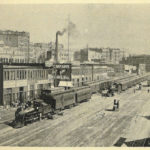
Industrial revolution transportation and communicationRoads, Railways and Canals. Lastly, in 1814, Stephenson employed the steam engine to develop a steam powered train, which would at some point allow improved communication and trade among locations before deemed also far. Quickly, the steam-powered train had turn into an icon of good results all through the globe ( Haberman 48). Britain encouraged the developing of railroads in other European countries, typically with British capital, gear, and technicians. Railroads became a standard item of British export ( Gernhard ).
The workday began and ended at certain instances. Many factory people worked up to 16 hours a day for quite little cash, because factory owners wanted to preserve production expenses low. Sometimes entire households went to work in factories: while males have been employed at iron and steel mills ,females and kids identified function in new textile factories. However, working conditions were bad and several workers became ill and died. There was no union at that time to protect them.
Railways developed in the initial half of the nineteenth century and, soon after a slow begin, boomed in two periods of railway mania. The industrial revolution was able to grow even far more, but a lot of of the key modifications had already begun with no rail. All of a sudden the reduced classes in society could travel significantly additional, a lot more very easily, and the regional differences in Britain began to break down.
Transportation For Childrenindustrial revolution transportation primary source
industrial revolution and transportationAmerican engineer and inventor Robert Fulton made the first commercially profitable steamboat in America in 1807, becoming a key supply of transportation on rivers and resulting in a substantial reduction in inland shipping fees. The development of so a lot of railroads changed American society. The railroad supplied indirect advantages by encouraging settlement and expansion of farming, therefore transforming agriculture. A lot much more of the fertile prairie could be created because the farmers now had access to national markets through the train. American cities were also influenced by railway improvement. Eastern seaports, along with other intermediate centers like Cincinnati, benefited from an increase in exportable goods.
This machine was very common during the Industrial Revolution, but the majority of people who utilized this or owned 1 had to be high class people or quite wealthy. There was not alot of them developed yet so alot of average individuals could not have one particular. At times they would just have a single in a town in a specific creating and the townspeople would have to take turns utilizing it, but in those days alot of individuals did not want to use the telephone a lot of folks would just go and tell the person in public, this was way less costly back in the day.
Westerners have been continually locating methods to bring far more land into cultivation. Regrettably, when they reached the sticky black soil of the treeless prairies, their wooden plows would break, generating it practically not possible to plant. The innovators of the time helped the farmers overcome the challenges they faced. In 1837, John Deere invented a steel plow that could break the soil and was light enough to be pulled by horses.
Transport Packaging In Industry 4.industrial revolution railways effects
industrial revolution 4.0 transportationBy the mid-nineteenth century, the American economy that had been primarily based on nearby commerce and modest-scale farming was maturing into a dynamic, wide-reaching capitalist marketplace. Before the Industrial Revolution, there was a time lag in almost almost everything that took location in the United States. It took weeks and at times months just to send a letter or pass info. It took months to send packages or goods across the country. Almost everything happened at a glacial pace. The Transportation Revolution changed all of that.
Canals had been reliable and financial. Barges on the canal have been pulled by horses that walked on either side of the canal on tow paths. One horse could pull a 30 tonne barge. Transportation was smooth and quickly. Travellers also used canals to move between towns and cities. The Industrial Revolution could not have developed with no coal and iron. Coal was required to make steam engines run and to make iron. At the starting of the 18 th century iron makers found a way to extract pure iron out of iron ore. They utilised coke, which was purer than coal and burned hotter, to melt the ore.
Steamboats had been also considerably much more comfortable than other forms of land transportation at the time. The Common Pike, launched in 1819, set the standard for luxurious steamers with marble columns, thick carpets, ornate mirrors, and plush curtains. Luxury steamers evolved into floating palaces exactly where passengers could dine, drink, dance, and gamble as they traveled to their destinations.
Transportation, The Next Business To Be Disrupted By The 4th Industrial Revolution
industrial revolution railways effectsAmerican engineer and inventor Robert Fulton made the very first commercially successful steamboat in America in 1807, becoming a significant supply of transportation on rivers and resulting in a considerable reduction in inland shipping charges. The spread of the web and the reasonably low price of digital technologies mean that people lucky adequate to have access to digital networks are becoming more worldwide and a lot more local at the very same time. Tiny traders in shanties on the outskirts of Nairobi export across east Africa. In China, ‘Taobao villages’ enable previously cut-off rural populations to sell goods on Alibaba’s trading platform.
In 1769, James Watt patented the steam engine and in effect created a new supply of power. Early-model steam engines had been introduced to drain water and raise coal from the mines, but the vital improvement was the use of steam for power ( Industrial Revolution: The Industrial Revolution in Excellent Britain ). The very first steam engine was in fact made by Thomas Newcomen, but Watt later enhanced and patented it. The original idea was to put a vertical piston and cylinder at the finish of a pump deal with and then to place steam in the cylinder and condense it with a spray of cold water. The vacuum designed allowed atmospheric stress to push the piston down, but Watt created it a reciprocating engine, producing the correct steam engine ( Gernhard ).
Britain was divided into a number of localities or parishes. Folks living in every single parish had been responsible for keeping the roads. Six days every year parishioners helped repair roads. Most roads experienced heavy usage. Six days of repair a year was not adequate to repair the roads adequately. There was no signposting and roads have been hard to navigate.




